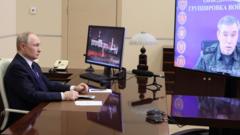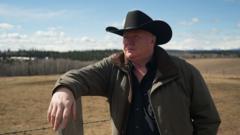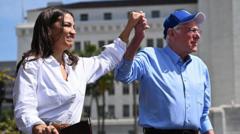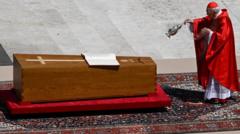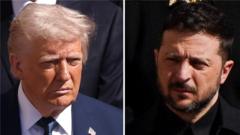The election campaign enters its final stretch with contrasting messages from Liberal leader Mark Carney and Conservative leader Pierre Poilievre as they seek to address voter concerns and the looming influence of U.S. politics.
**Canada's Political Landscape Shifts Dramatically Ahead of Key Election**
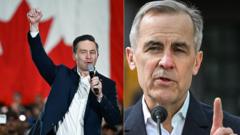
**Canada's Political Landscape Shifts Dramatically Ahead of Key Election**
As Canada approaches a pivotal federal election, both major parties experience unexpected political dynamics amidst international pressures.
In the face of an evolving political climate, Canada's federal election is shaping up to be one of the most critical in recent memory. The ongoing tension with the U.S., particularly under President Trump's administration, has consolidated voter sentiment around both major parties with distinct narratives. Liberal leader Mark Carney has garnered attention by framing himself as a stabilizing force ready to defend national integrity against perceived threats from south of the border. At rallies, he has been met with fervent support, particularly as he draws on his experience in economic crises to reassure Canadians amid external anxieties.
Conversely, Pierre Poilievre, the Conservative leader, has energized his base with calls for change, asserting that the current Liberal government has failed on various fronts including housing and socio-economic issues. Rallying cries such as "Bring it Home" emphasize a wave of Canadian patriotism aimed at countering tariffs and international pressures. Polls suggest the race is tightly contested as voters gauge the candidates’ responses to a potentially volatile U.S.-Canada relationship, accentuated by Trump's recent tariff announcements on foreign goods.
Emerging from a tumultuous year where the political landscape shifted dramatically—marked by Trudeau's resignation and Carney's ascendance—the election has seen an uptick in traditional Liberal support as disaffected voters re-align. Analysts note that Trump's insistence on tariffs and his controversial remarks on Canada's sovereignty have acted as a catalyst, consolidating a pro-Liberal sentiment among those fearing U.S. economic expansionism.
A notable divide has also emerged between the two candidates regarding leadership styles. Carney's non-political background allows him to offer a fresh perspective, drawing on economic expertise to win favor among cautious electorates. Meanwhile, Poilievre's polished performance as a seasoned politician seeks to resonate with a desire for a strong shift away from current governance.
As the electorate heads to the polls, both parties must also navigate the burgeoning influence of smaller parties like the NDP, who urge strategic voting to ensure their voices aren't drowned out by the larger spectrum. The intersection of regional interests, economic priorities, and the shadow of the U.S. will likely define this electoral moment, ushering in uncertainty about Canada's political future.
With both major parties polling competitively and emotional appeals resonating throughout Canada, the electorate holds a pivotal role in determining not just the future governance but the broader direction of national identity amidst global pressures. In the final hours of campaigning, Carney pledges experience-oriented leadership, while Poilievre calls for change and a reclaiming of control, positioning voters to make a decision that could shape Canada's trajectory for years to come.
Conversely, Pierre Poilievre, the Conservative leader, has energized his base with calls for change, asserting that the current Liberal government has failed on various fronts including housing and socio-economic issues. Rallying cries such as "Bring it Home" emphasize a wave of Canadian patriotism aimed at countering tariffs and international pressures. Polls suggest the race is tightly contested as voters gauge the candidates’ responses to a potentially volatile U.S.-Canada relationship, accentuated by Trump's recent tariff announcements on foreign goods.
Emerging from a tumultuous year where the political landscape shifted dramatically—marked by Trudeau's resignation and Carney's ascendance—the election has seen an uptick in traditional Liberal support as disaffected voters re-align. Analysts note that Trump's insistence on tariffs and his controversial remarks on Canada's sovereignty have acted as a catalyst, consolidating a pro-Liberal sentiment among those fearing U.S. economic expansionism.
A notable divide has also emerged between the two candidates regarding leadership styles. Carney's non-political background allows him to offer a fresh perspective, drawing on economic expertise to win favor among cautious electorates. Meanwhile, Poilievre's polished performance as a seasoned politician seeks to resonate with a desire for a strong shift away from current governance.
As the electorate heads to the polls, both parties must also navigate the burgeoning influence of smaller parties like the NDP, who urge strategic voting to ensure their voices aren't drowned out by the larger spectrum. The intersection of regional interests, economic priorities, and the shadow of the U.S. will likely define this electoral moment, ushering in uncertainty about Canada's political future.
With both major parties polling competitively and emotional appeals resonating throughout Canada, the electorate holds a pivotal role in determining not just the future governance but the broader direction of national identity amidst global pressures. In the final hours of campaigning, Carney pledges experience-oriented leadership, while Poilievre calls for change and a reclaiming of control, positioning voters to make a decision that could shape Canada's trajectory for years to come.


